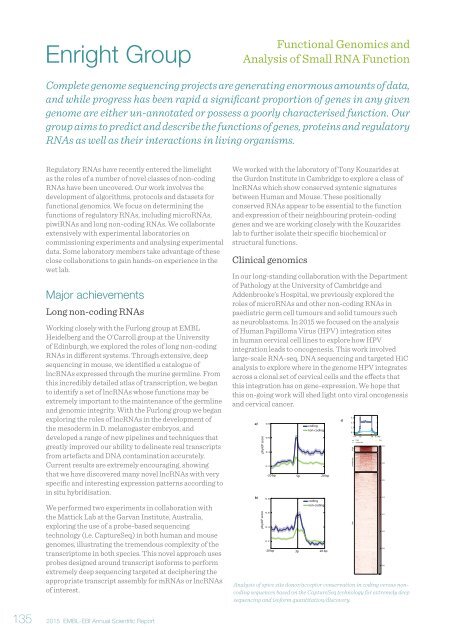Annual Scientific Report 2015
EMBL_EBI_ASR_2015_DigitalEdition
EMBL_EBI_ASR_2015_DigitalEdition
Create successful ePaper yourself
Turn your PDF publications into a flip-book with our unique Google optimized e-Paper software.
Enright Group<br />
Functional Genomics and<br />
Analysis of Small RNA Function<br />
Complete genome sequencing projects are generating enormous amounts of data,<br />
and while progress has been rapid a significant proportion of genes in any given<br />
genome are either un-annotated or possess a poorly characterised function. Our<br />
group aims to predict and describe the functions of genes, proteins and regulatory<br />
RNAs as well as their interactions in living organisms.<br />
Regulatory RNAs have recently entered the limelight<br />
as the roles of a number of novel classes of non-coding<br />
RNAs have been uncovered. Our work involves the<br />
development of algorithms, protocols and datasets for<br />
functional genomics. We focus on determining the<br />
functions of regulatory RNAs, including microRNAs,<br />
piwiRNAs and long non-coding RNAs. We collaborate<br />
extensively with experimental laboratories on<br />
commissioning experiments and analysing experimental<br />
data. Some laboratory members take advantage of these<br />
close collaborations to gain hands-on experience in the<br />
wet lab.<br />
Major achievements<br />
Long non-coding RNAs<br />
Working closely with the Furlong group at EMBL<br />
Heidelberg and the O’Carroll group at the University<br />
of Edinburgh, we explored the roles of long non-coding<br />
RNAs in different systems. Through extensive, deep<br />
sequencing in mouse, we identified a catalogue of<br />
lncRNAs expressed through the murine germline. From<br />
this incredibly detailed atlas of transcription, we began<br />
to identify a set of lncRNAs whose functions may be<br />
extremely important to the maintenance of the germline<br />
and genomic integrity. With the Furlong group we began<br />
exploring the roles of lncRNAs in the development of<br />
the mesoderm in D. melanogaster embryos, and<br />
developed a range of new pipelines and techniques that<br />
greatly improved our ability to delineate real transcripts<br />
from artefacts and DNA contamination accurately.<br />
Current results are extremely encouraging, showing<br />
that we have discovered many novel lncRNAs with very<br />
specific and interesting expression patterns according to<br />
in situ hybridisation.<br />
We performed two experiments in collaboration with<br />
the Mattick Lab at the Garvan Institute, Australia,<br />
exploring the use of a probe-based sequencing<br />
technology (i.e. CaptureSeq) in both human and mouse<br />
genomes, illustrating the tremendous complexity of the<br />
transcriptome in both species. This novel approach uses<br />
probes designed around transcript isoforms to perform<br />
extremely deep sequencing targeted at deciphering the<br />
appropriate transcript assembly for mRNAs or lncRNAs<br />
of interest.<br />
We worked with the laboratory of Tony Kouzarides at<br />
the Gurdon Institute in Cambridge to explore a class of<br />
lncRNAs which show conserved syntenic signatures<br />
between Human and Mouse. These positionally<br />
conserved RNAs appear to be essential to the function<br />
and expression of their neighbouring protein-coding<br />
genes and we are working closely with the Kouzarides<br />
lab to further isolate their specific biochemical or<br />
structural functions.<br />
Clinical genomics<br />
In our long-standing collaboration with the Department<br />
of Pathology at the University of Cambridge and<br />
Addenbrooke’s Hospital, we previously explored the<br />
roles of microRNAs and other non-coding RNAs in<br />
paediatric germ cell tumours and solid tumours such<br />
as neuroblastoma. In <strong>2015</strong> we focused on the analysis<br />
of Human Papilloma Virus (HPV) integration sites<br />
in human cervical cell lines to explore how HPV<br />
integration leads to oncogenesis. This work involved<br />
large-scale RNA-seq, DNA sequencing and targeted HiC<br />
analysis to explore where in the genome HPV integrates<br />
across a clonal set of cervical cells and the effects that<br />
this integration has on gene-expression. We hope that<br />
this on-going work will shed light onto viral oncogenesis<br />
and cervical cancer.<br />
a)<br />
b)<br />
phyloP score<br />
phyloP score<br />
-20 bp 5p<br />
-20 bp 3p<br />
coding<br />
non-coding<br />
20 bp<br />
coding<br />
non-coding<br />
20 bp<br />
Analysis of spice site donor/acceptor conservation in coding versus noncoding<br />
sequences based on the CaptureSeq technology for extremely deep<br />
sequencing and isoform quantitation/discovery.<br />
c)<br />
135<br />
<strong>2015</strong> EMBL-EBI <strong>Annual</strong> <strong>Scientific</strong> <strong>Report</strong>


